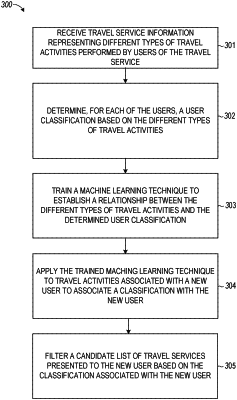| CPC G06Q 10/025 (2013.01) [G06N 5/04 (2013.01); G06N 20/00 (2019.01); G06Q 20/127 (2013.01); G06Q 30/0206 (2013.01); G06Q 30/0631 (2013.01); G06Q 30/0643 (2013.01); G06Q 50/14 (2013.01); G06F 3/0482 (2013.01); G06F 3/04847 (2013.01)] | 18 Claims |

|
1. A computer-implemented method comprising:
receiving, by one or more processors, travel information with a travel date for a user;
computing, by the one or more processors, a subscription value as a function of a booking date and the travel date, the subscription value comprising an accumulated value portion and an amortized value portion, the accumulated value portion calculated by determining a time interval between the booking date and the travel date and accumulating the subscription value over the time interval;
determining, by the one or more processors, a minimum travel value and a maximum purchase amount based on the subscription value;
training a machine-learning model to associate classifications with users based on travel services activities of the users and using a log odds model to estimate coefficients of the machine-learning model, wherein the travel services activities of the users used to train the machine-learning model comprise quantities of reservations made by the users, subscription durations of the users, distances to travel destinations for the users, margin amounts for the users, reservation frequencies of the users, and cancelation frequencies of cancelations by the users, and wherein the classifications represent activity levels for the users;
generating a classification for the user based on (i) the coefficients of the machine-learning model, as trained, and (ii) travel activities of the user;
selecting a subset of candidate travel services by filtering candidate travel services based on (i) the classification of the user generated by the machine-learning model, as trained, (ii) the travel date, (iii) the minimum travel value, and (iv) the maximum purchase amount;
receiving a request from the user via an interactive graphical user interface to reserve a given travel service having a first cost that exceeds the minimum travel value and a second cost that is less than the maximum purchase amount;
identifying a travel end date for the given travel service; and
preventing the user from reserving an additional travel service for a specified period of time of the travel end date, the preventing including disallowing the user to search for the additional travel service within the interactive graphical user interface.
|